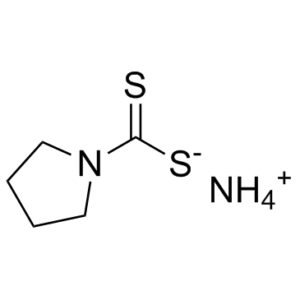Pyrrolidinedithiocarbamate ammonium
This product is for research use only, not for human use. We do not sell to patients.

For small sizes, please check our retail website as below: www.invivochem.com
| Size | Price | Stock |
|---|---|---|
| 5g | $240 | Check With Us |
| 10g | $400 | Check With Us |
| 20g | $600 | Check With Us |
Cat #: V3143 CAS #: 5108-96-3 Purity ≥ 98%
Description: Ammonium pyrrolidine dithiocarbamate (also abbreviated as PDTC) is a potent nuclear factor-κB (NF-κB) inhibitor.
Top Publications Citing Invivochem Products
Publications Citing InvivoChem Products
Product Promise

- Physicochemical and Storage Information
- Protocol
- Related Biological Data
- Stock Solution Preparation
- Quality Control Documentation
| Molecular Weight (MW) | 164.29 |
|---|---|
| Molecular Formula | C5H9NS2.H3N |
| CAS No. | 5108-96-3 |
| Storage | -20℃ for 3 years in powder formr |
| -80℃ for 2 years in solvent | |
| Solubility In Vitro | DMSO: >35 mg/mLr |
| Water: >35 mg/mLr | |
| Ethanol: >35 mg/mL | |
| SMILES Code | [S-]C(N1CCCC1)=S.[NH4+] |
| Synonyms | Pyrrolidinedithiocarbamate ammonium; Ammonium 1-Pyrrolidinecarbodithioate; PDTC; APDC. |
| Protocol | In Vitro | Pyrrolidinedithiocarbamate ammonium inhibits the activation of NF-κB, because it suppresses both NF-κB DNA binding and NF-κB-dependent transcriptional activity. NF-κB inhibition with pyrrolidinedithiocarbamate ammonium decrease IL-8 production by intestinal epithelial cells. Furthermore, pyrrolidinedithiocarbamate ammonium (100 μM) suppresses the accumulation of IL-8 mRNA. Pretreatment of cells with Pyrrolidinedithiocarbamate ammonium (Ammonium pyrrolidinedithiocarbamate; 3-1000 μM) dose-dependently attenuate IL-8 production. |
|---|---|---|
| In Vivo | The DSS+pyrrolidinedithiocarbamate ammonium-treated groupII exhibits suppression of shortening of intestinal length and reduction of DAI score. Activated NF-κB level and IL-1β and TNF-α levels are significantly lower in DSS+pyrrolidinedithiocarbamate ammonium-treated groupII. These findings suggest that suppression of NF-κB activity by pyrrolidinedithiocarbamate ammonium can delay the healing of mucosal tissue defects (erosions or ulcers) arising from inflammation, but that it can strongly suppress the expression of inf-lammatory cytokines (IL-1β and TNF-α), resulting in significant alleviation of colitis. pyrrolidinedithiocarbamate ammonium is useful for the treatment of ulcerative colitis. |
These protocols are for reference only. InvivoChem does not
independently validate these methods.
| Solvent volume to be added | Mass (the weight of a compound) | |||
|---|---|---|---|---|
| Mother liquor concentration | 1mg | 5mg | 10mg | 20mg |
| 1mM | 6.0868 mL | 30.4340 mL | 60.8680 mL | 121.7360 mL |
| 5mM | 1.2174 mL | 6.0868 mL | 12.1736 mL | 24.3472 mL |
| 10mM | 0.6087 mL | 3.0434 mL | 6.0868 mL | 12.1736 mL |
| 20mM | 0.3043 mL | 1.5217 mL | 3.0434 mL | 6.0868 mL |
The molarity calculator equation
Mass(g) = Concentration(mol/L) × Volume(L) × Molecular Weight(g/mol)
Mass
=
Concentration
×
Volume
×
Molecular Weight*
The dilution calculator equation
Concentration(start)
×
Volume(start)
=
Concentration(final)
×
Volume(final)
This equation is commonly abbreviated as: C1 V1 = C2 V2
Concentration(start)
C1
×
Volume(start)
V1
=
Concentration(final)
C2
×
Volume(final)
V2
Step One: Enter information below
Dosage mg/kg
Average weight of animals g
Dosing volume per animal µL
Number of animals
Step Two: Enter the in vivo formulation
%DMSO
+
%
+
%Tween 80
+
%ddH2O
Calculation Results:
Working concentration:
mg/ml;
Method for preparing DMSO master liquid:
mg
drug pre-dissolved in
µL
DMSO(Master liquid concentration
mg/mL)
,Please contact us first if the concentration exceeds the DMSO solubility of the batch of drug.
Method for preparing in vivo formulation:
Take
µL
DMSO master liquid, next add
µL
PEG300, mix and clarify, next add
µL
Tween 80,mix and clarify, next add
µL
ddH2O,mix and clarify.
Note:
- (1) Please be sure that the solution is clear before the addition of next solvent. Dissolution methods like vortex, ultrasound or warming and heat may be used to aid dissolving.
- (2) Be sure to add the solvent(s) in order.




































